Wellness in Travel
Making our Airports Resilient and Responsive to Air Passenger Needs
Written by: Clint Laaser, Jordan Roos, Richard Barone, Matt Lee, and Joe Barden with contributions by Ibrahim Ibrahim, Portland Design and Mike Zoia, Ross & Baruzzini
Table of Contents
The global pandemic has upended travel. Airport facilities are idle or operating at just a fraction of normal levels. Over the past year, domestic air passenger demand throughout most of the world has been less than half of pre-pandemic levels and there has been just a trickle of international travel. Airports and airlines have done their best with limited guidance and resources to address the public’s concerns and restore confidence. These measures have mostly amounted to quick interventions (i.e. plexiglass barriers, floor stickers, etc.) that are considered temporary and can be removed once the current crisis abates. However, as the pandemic persists, it is becoming more apparent that our industry must make more permanent investments that prepare airports for future events. In addition, we must modify our airports to accommodate changes in air passenger behaviors that the current crisis has accelerated or induced.
Changes in Passenger Behavior and Airport Facilities
Airports and industry experts are constantly learning how COVID-19 has affected passenger behavior. Many previous behavioral patterns have changed, some have been reinforced. The aviation industry will inevitably return to 2019 activity levels sometime over the next few years; however, some changes to passenger behavior as a result of COVID-19 will persist.
Global passengers will demand far simpler, more convenient, and defined experiences both in the terminal and in the air. To remain competitive in a post-COVID-19 world, airports must understand the types of customers they serve, and what they want out of their terminal experience.
Prior to COVID-19, there were three basic passenger types based on behavioral patterns – the camper, roamer and explorer. The illustration below describes each passenger type and shows the different ways they each navigate and spend their time at the airport. These passenger types still exist, but some patterns have intensified, and some have lessened or become blurred. One major behavior pattern change is the acceleration of the wellness trend for passengers. Wellness-focused passengers are no longer a category of passenger because of COVID-19; all passengers are more focused on wellness. Moving forward, airports must include wellness-focused offerings in the terminal to maintain a happy journey for passengers.
The Three Passenger Types – Interaction at Airport Terminals
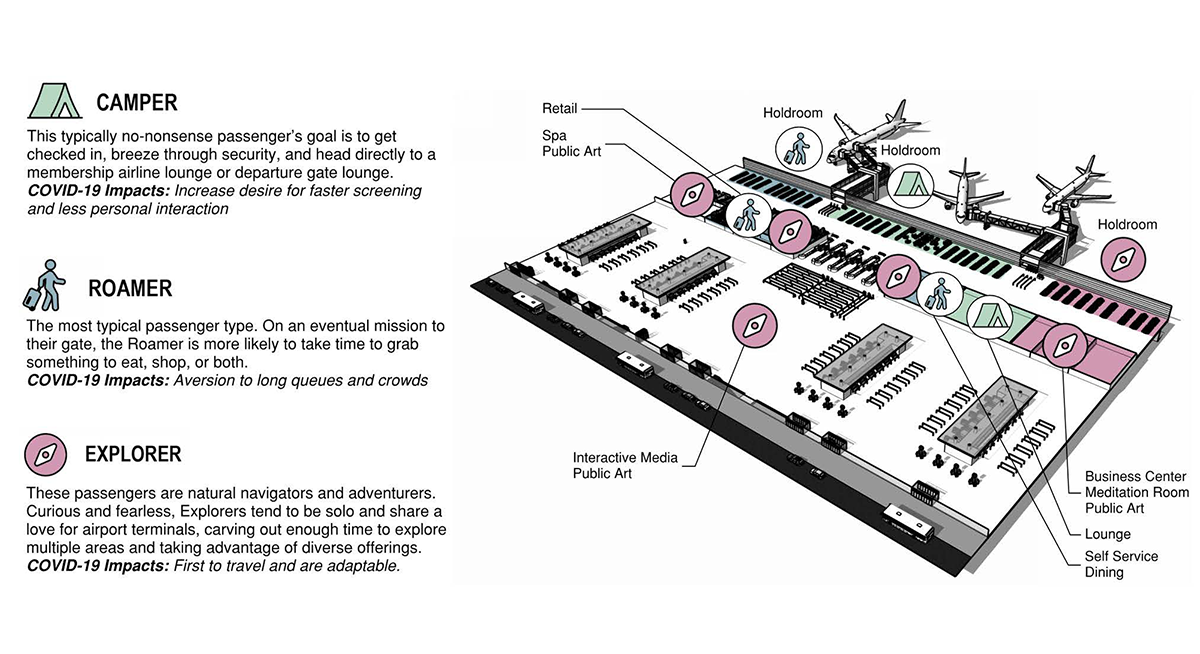
Source: L&B
Design and technology interventions must account for the needs of each of these three passenger types. It is unclear at this time what type will be dominant, especially as the industry will likely rely more on the leisure travel in coming years, which has the greatest variety of traveler behaviors. More than ever, airports will need to be flexible and attempt to accommodate all three passenger types as much as they can.
In response to the pandemic many airports introduced social distancing policies, installed temporary physical barriers, and increased the pace of the rollout of touchless technologies. These measures have had mixed success. Passengers have ignored social distancing guidance. The other measures have only marginally adjusted how passengers use terminal spaces and functions versus pre-pandemic conditions. Airports, airlines, and terminal operators currently are navigating an uncertain regulatory and fiscal environment that has limited the success of their pandemic responses.
In the United States, more clear and uniform pandemic management policies and additional funding are possible with the new Federal administration and Congress. Aviation is an instrument of interstate commerce whose needs transcend a State by State approach. The lack of a national strategy has sown confusion among passengers as they attempt to navigate the differing policies in force in each State.
To date, governments have supported aviation by focusing on maintaining employment. This support has enabled airports to avoid drastic budget cuts in response to sharply reduced direct revenues. The industry greatly appreciates the government support it has received. However, going forward, airports will need new support to implement the critical infrastructure changes necessary to mitigate future pandemics.
As it relates to health and wellness, most of the critical infrastructure changes will occur within airport terminals. Rethinking the program of airport terminals addresses three critical needs:
- Restoration: Restoring confidence to the flying public as we work over the next year or so to return to pre-COVID levels of demand.
- Resilience: Preparing the airport to better mitigate/manage future health related events, which many experts fear like extreme weather events will become more frequent.
- Experience: Improving the passenger experience at the airport by reducing friction at check-in, security and boarding – making the trip easier and faster than it was before – and targeting new services that make the airport more than just a waiting room.
Restoration: Technology Supporting and Driving the Transformation of Space
The industry is already leveraging technology to limit air passenger exposure to the virus and restore confidence in air travel. These technological changes were already underway prior to the pandemic. As the internet matured and its commercial applications expanded, the aviation industry began to leverage the technology to allow for new services such as remote flight check-in from your home or office. The popularity of the option surged once mobile devices entered the scene. Consequently, as more air passengers adopted mobile devices, the space requirements for check-in halls decreased with some of this space being reapportioned for the installation of kiosks to support self-checked baggage. These trends will continue and begin to encompass other areas of the terminal and adoption of these technologies is likely to accelerate due to the pandemic.
The application of new technologies at airports can help to eliminate the friction of security screening checkpoints by reducing or eliminating queues. Some of these technologies include:
- Realtime wait-time information, enabling customers to see the estimated wait at security screening checkpoints and allow them to shift to a checkpoint with shorter wait times including integration with airline mobile apps enabling a more informed passenger to avoid overcrowding.
- Realtime queue management, using the data collected to generate wait times along with additional sensors placed in garages and check-in areas that would provide added situational awareness, airport managers can adjust the checkpoints to be responsive to surges in demand. Video-based Queue management systems, for example, can also allow for additional video analytics “add-ons” such as notification of social distancing, temperature anomalies, and capacity thresholds.
- Security screening reservation systems, eliminate or substantially reduce security screening queues all together, which also supports social distancing and reduces the opportunity for transmission of disease (since many queues snake and result in face-to-face situations). These online reservations systems already exist for restaurants and other venues (observation decks) and during COVID have been leveraged by various organizations/industries to manage crowding and queues. Airports are also beginning to pilot these solutions, with Denver International Airport recently implementing a solution developed by Verifly that “health-conscious” passengers can choose to use. A slot-based security screening system could be integrated into airline applications and would allow customers to cut down on the time they spend at the airport – creating a more seamless, healthy, and enhanced passenger experience. Reservation systems can also be integrated with testing or health screening requirements to manage the overall check-in experience.
Application of Select Technologies in Terminals

Source: L&B and R&B
IATA Travel Pass: How Apps Access and Relay Traveler Health Information
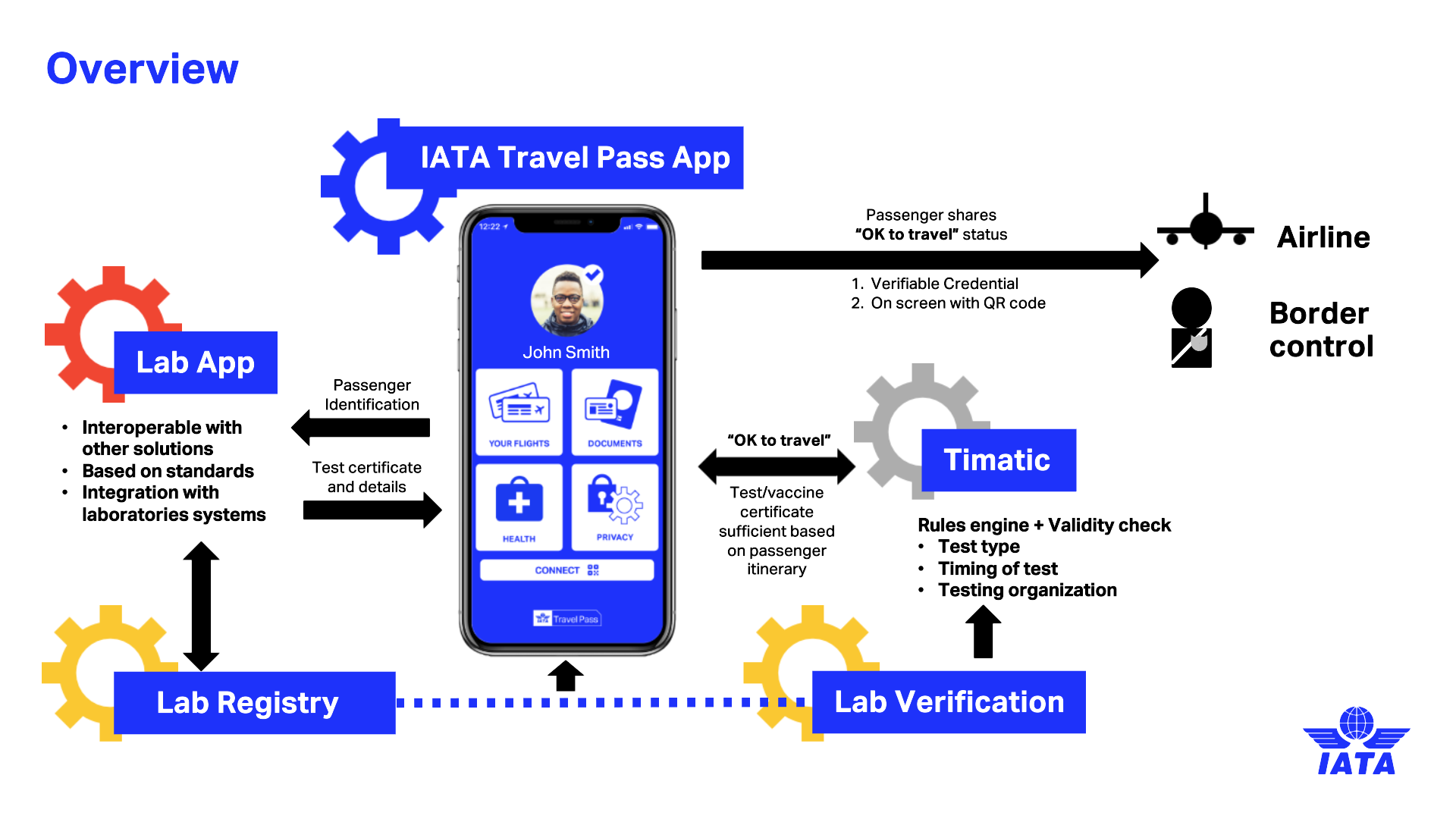
Source: IATA
- Biometric and Touchless based screening, the continued use of biometrics and touchless technologies throughout the screening process will minimize the physical interaction between the TSA Officers and the passenger, allowing for physical interactions only when required for security enforcement. Passengers will be able to more efficiently process through a security checkpoint with greater ease with less potential for infection.
- Automated screening and boarding gate applications, expanding the use of automatic boarding gates to minimize the interactions between the Airline Boarding Agents and passengers. The process flows and space should also be evaluated to allow a more organized boarding process to avoid large crowds forming prior to boarding. This technology could also be installed prior to screening to automate the health and security check-in process.
In addition to improved queue management, airports will need to invest in technologies that enable them to better manage the environment of their facilities. More active management of Heating Ventilation and Air Conditioning (HVAC) systems will improve the health of the terminal environment and prepare the airport for future public health crises. Technologies to filter air using ultra-violet light to kill germs and viruses along with the finer grain ability to control humidity levels – reducing the time a virus will remain airborne – can be used to mitigate transmission.
Since the outbreak of COVID-19, airports and airlines have deployed touchless technologies at a greater pace, and they are actively exploring their more widespread applications. While it was found early on, that contact with surfaces was not the primary means of transmission for COVID-19, this is not true for all viruses and diseases.
Whether it is eliminating touching a screen to complete payment at a concession (e.g. Apple or Google pay), pressing a button to call an elevator or using a kiosk touchscreen to check-in, our mobile devices will become our personal control surfaces – a shift that is already occurring. The airports, airlines and terminal operators will also implement other forms of biometrics, such as facial, retina, and gait recognition as an alternative to “touch” based biometrics such as fingerprints.
Resilience: Arrival and/or Departure Health Screening
Returning air travel to flows that resemble pre-pandemic patterns will require immediate actions to restore confidence in air travel and multi-year investments to ensure the future wellness of air passengers. All approaches to health screening will be layered by relying on multiple methods to determine the fitness of passengers for travel.
Over the coming months, many airlines and national governments will be using Health Passport apps such as the Verifly Health Passport or the IATA Travel Pass to confirm that passengers meet the requirements to travel, as defined by health authorities at the destinations. These apps provide a health status rating (green or red, pass or go to secondary screening) by evaluating a number of factors which includes a negative COVID test within a specified time period, location-based tracking that identifies whether a passenger was in high-positivity areas, proximity to individuals that have tested positive, proof of vaccination (if applicable) or how a traveler answered questions on a mobile screening questionnaire. At a minimum, airlines will need to modify their systems to include the health status of their passengers on aircraft manifests and adjust their check-in procedures to capture this information from apps or paper documents. Airlines have an incentive to ensure that passengers can travel to their destinations because local authorities may, at worst, refuse to allow undocumented passengers disembark or require these passengers to endure lengthy quarantines.
Local or national regulators may choose to provide an additional layer of health screening by including an independent check of passenger health documentation during the departure process and/or during the arrival process. In addition to checking health documentation, regulators could also require temperature screening of passengers potentially with a two-tiered process that uses thermal imaging on all passengers to identify those that require an additional check with more sensitive equipment.
Longer term, the world has a strong interest in mitigating the potentially devastating consequences of future pandemics. The U.S. Congress is already considering legislation that will require the Department of Transportation, in collaboration with the Department of Health and Human Services, the Department of Homeland Security, and other relevant federal agencies, to develop a national aviation preparedness plan to tackle future communicable disease outbreaks, as first recommended by the U.S. Government Accountability Office (GAO) in 2015 following the Ebola outbreak.3
Such plans include a tiered border protection response that depends upon the severity and the type of outbreak and provide facilities at airports to implement the additional health screening, quarantines, and specialized passenger transport the border protection plans will likely require.
Public health screening for departing domestic and international passengers will necessitate the reconfiguration and possible expansion of checkpoint areas to accommodate secondary screening areas and segregated quarantine corridors to safely move passengers that require medical attention to onsite or offsite medical facilities. Secondary screening sites will need space to administer rapid testing, if needed, and have customers answer questionnaires or undergo additional screening examinations.
At some terminals, sufficient space to support these activities exists or might be made available through the introduction of new technologies, including reservation-based security screening, which might negate the need to establish large areas set aside in terminals to support snaking queues. In all cases consideration should be given to screening locations that occur before areas with large assemblies of passengers. These added health screening spaces and protocols do not need to be permanent fixtures at our airports but can be flexible spaces which are available to be rapidly enabled during a health crisis.
Critical to the success of these plans is an understanding of how they affect the capacity of airports to process passengers through the border facilities.
The “Transumer” Airport Experience
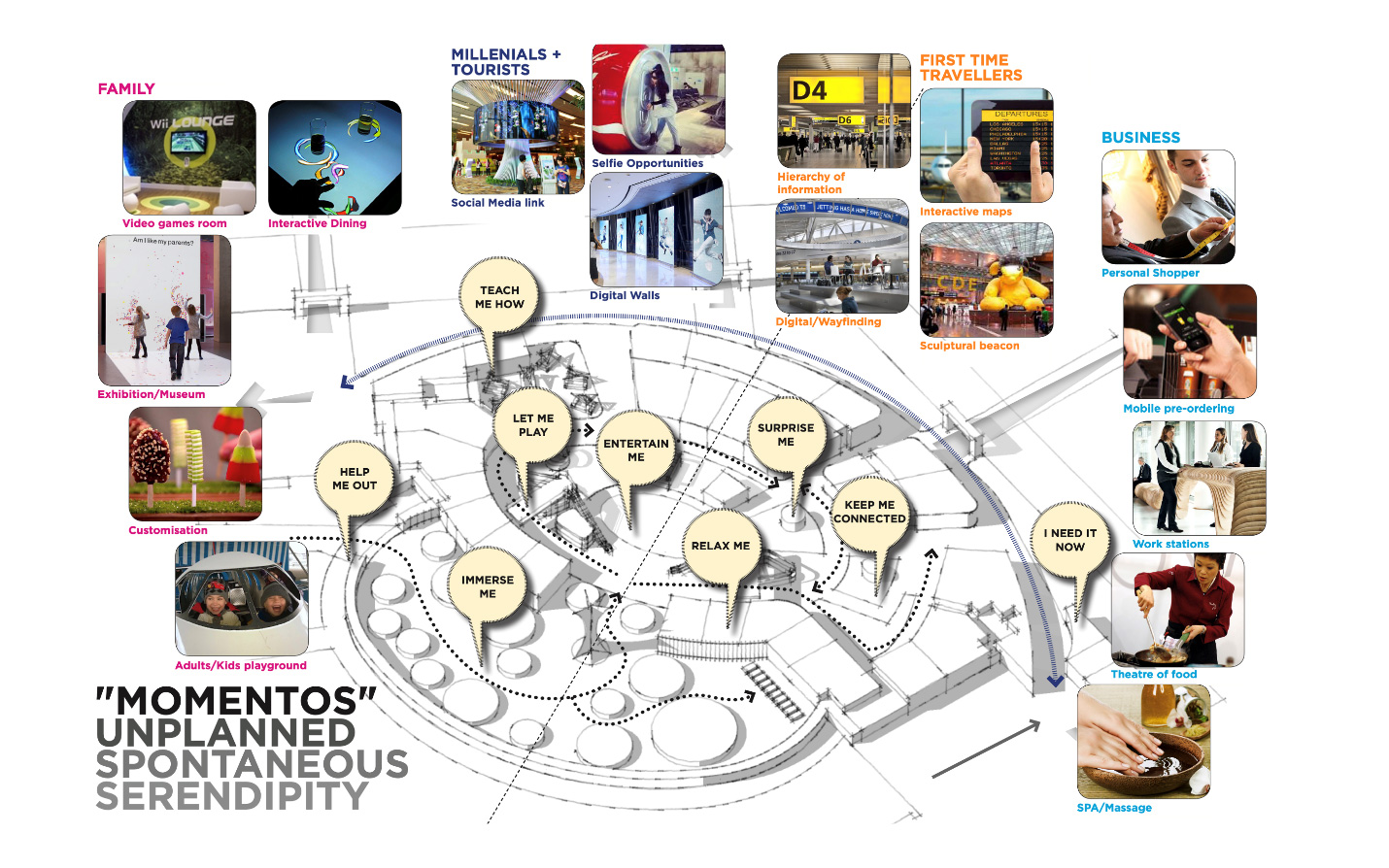
Source: Portland Design
This involves testing of the response plans through tabletop exercises, simulation modeling and/or field testing. These plans will likely require the prepositioning of personal protective equipment and other testing equipment at airports. Airports will need to accommodate the response plans into their overall emergency response plans and train staff in the new procedures.
Experience: Reprogramming Terminal Space for a Post-COVID World
As discussed earlier, COVID-19 has had a profound effect on air passenger behavior, and this has typically translated to a fear of crowds and being in close proximity to others for an extended duration. Pre-pandemic, airports were already moving away from using holdrooms as a dominant waiting space and efforts were underway to spread out customers and engage them by creating new services and amenities. This crisis will accelerate the trend to a more decentralized experience, creating a variety of new spaces to cater to specific preferences and tolerances of the three passenger types – the camper, roamer and explorer. For instance, the desire of campers and roamers to wait in a less crowded space could be accommodated through office or resting suite rental or private seating pods that are distanced. While the explorers that wish to socialize or even climb an indoor mountain could also be satisfied.
COVID-19 driven “working from home” may present an interesting opportunity for airports. Passengers, especially explorers, may be tempted to get away from home and arrive at the airport early to do a day’s work before taking a flight. Airports could respond to this by developing a compelling co-working offering as part of the commercial experience that is integrated with retail, food & beverage, entertainment and wellness.
This approach responds well to the “dip in-dip out” culture of work that co-working represents.
Reservations at security screening may also result in passengers choosing to arrive early to avoid waiting in line, just as dinning apps lure us to arrive early when preferred times are taken. “Optimized scheduling” applications in high demand terminal environments will flatten the arrival curve, resulting in some passengers spending more time in the commercial areas and less time waiting in line. Of course, this will change both the revenue model and the commercial master planning and design of the terminal.
Airport retail has been changing for years – moving from traditional brick and mortar concessions to self-service kiosks and more recently changing to on-demand delivery to your gate by leveraging capabilities of mobile devices and location-based services. These services have been popular with campers and their popularity has only expanded during COVID-19. The pandemic has trained people to be comfortable with delivery-based shopping, reducing the need to physically shop at stores and shopping malls. Airport retail was already evolving in this direction prior to the pandemic. The pandemic has accelerated these changes because of passenger’s newly found comfort with online/delivery shopping.
When consumers travel through airports, they often have a very different mindset than when they are on main street or in shopping malls. They engage with brands in a very different way in airports, and so we refer to them as “Transumers” (Travelling Consumers).
Transumers are often in an unfamiliar environment, they can be disoriented and stressed. They may also be over excited, and adrenalin driven. The degree of these behaviors varies by the three passenger types with campers being the most stressed and explorers the most excited. To respond to this unique mindset, we must plan and design intuitive, simple and easy airport commercial offerings. Research has shown that many passengers find the airport commercial offerings boring, uninspiring and uniform across the airports they visit. To gain the attention of the Transumer the airport commercial experience must deliver surprise, constant newness and serendipity, along with good value and convenience. Airport retailers, brands and food and beverage operators must design and deliver their offers to meet both physical and emotional needs of the Transumer. Airports have the opportunity to deliver new experiences, ideas and brands that differ from shopping malls by communicating clearly and accommodating groups with baggage.
Consumers now expect a range of service options in addition to conventional delivery to lounges, gates or arrivals. Airports now should consider more personalised geo-located delivery anywhere in the terminal either by person or robot. In the future, consumers will expect goods to be delivered into the trunk of their car, which they will be able to open remotely from wherever they are, as their cars will be internet connected.
A luxury fulfilment experience is another future option. A concierge type offering in a lounge setting that showcases branded products and services while delivering customer’s goods directly to them as part of a premium hospitality experience would appeal to all three passenger types.
In the future, completing transactions will consume less of the physical retail space. Increasingly, brands will use the physical spaces to recruit customers and then drive them to online E-Commerce sites or social media platforms. So, the future airport commercial masterplan will shift space from accommodating transactional retail space to customer “recruitment” space. The former will be more conventional with fixed units segmented into retail categories. However, the latter will take the form of a stage set or exhibition space, which would appeal to both roamers and explorers. To deliver the experiences that recruit customers, space will need to be infinitely programmable to accommodate event driven experiences that are blended with food, wellness, entertainment, social and dwelling spaces.
The Transumer journey will become increasingly elastic, whereby brands will need to engage with customers along the whole journey, i.e. before, during and after the airport visit. Mobile connectivity and engagement will be the glue that binds a continuous journey experience.
When brands use the physical spaces in an airport as customer recruitment platforms, they are behaving like a media brand. Airports have the potential to become the most powerful and effective media platform available to a brand. This new approach greatly changes the design and planning and design of the terminal.
It also has the potential to reduce capital and operating expenses because modular, open-cell, programmable spaces are more cost effective to build and operate.
The specific passenger profile at each airport will drive how airport commercial zones are divided between transaction and recruitment spaces. Planners will need to use targeted passenger surveys to understand each airport’s unique mix of the three passenger types and how they want to experience their travel.
While terminal concourses are predominately where the opportunities for transformational design interventions exist, check-in and security screening will also change or more specifically continue their evolution. The requirements for these spaces have changed over the past decade due to the advent of technology, which will continue to drive their transformation.
Translating Ideas to Action
COVID-19 is not like anything the modern world has ever experienced – it has cost millions of lives and resulted in an economic cost amounting to trillions of dollars. Airlines, and the airports that underpin them, will need to make transformative investments in their facilities and leverage the vast capabilities of existing and nascent technologies. The aviation industry will require the guidance and support of national governments to fully recover. Government action must be informed by expertise, “best practices” and data. While a national strategy, as recommended by the U.S. GAO, to prepare the aviation industry for events is essential, it must be paired with funding to support these core investments. To protect the wellness of air travelers we must prepare our airports to weather future public health crises. By investing now, we will not only ensure that the global aviation system is resilient in a crisis, but also improve its efficiency and the overall travel experience for the flying public.
Monthly Total Chinese Airline Domestic and International Scheduled Seating Capacity
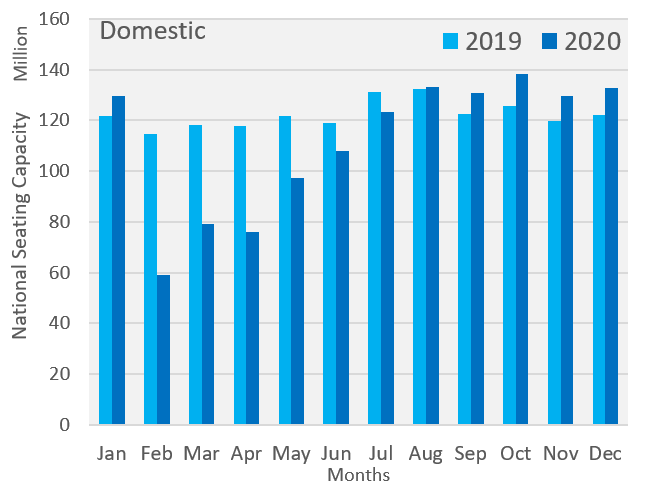
Source: Diio Mi Schedule Data by Cirium
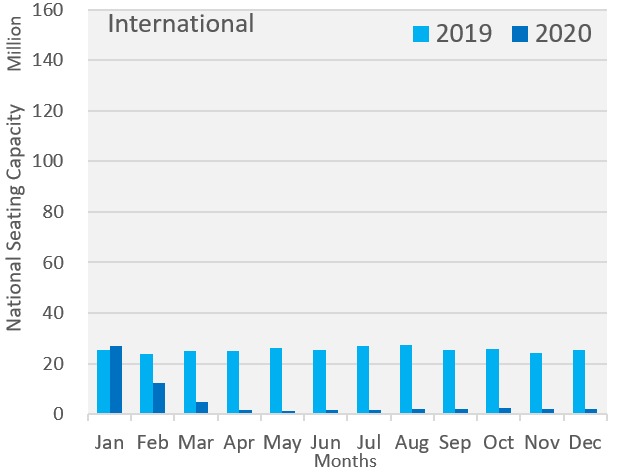
Due to the absence of domestic travel markets, traffic at Hong Kong International Airport (HKG), Macau International Airport (MFM), and Taipei International Airport (TPE) had far greater declines than in the rest of China. Passenger traffic for HKG collapsed from 71.5 Million Annual Passengers (MAP) in 2019 to 8.8 MAP in 2020; MFM from 9.6 MAP to 1.2 MAP; and TPE from 48.7 MAP to 7.44 MAP. Combined, all three airports experienced a staggering 85% reduction in passenger traffic.
1 Developed by Daon, for British Airways and American Airlines, https://www.daon.com/, Accessed 2/10/2020
2 International Air Transport Association, Dec. 2020, https://www.iata.org/en/programs/passenger/travel-pass/, Accessed 2/10/2020
3 Air Travel and Communicable Diseases, United States Government Accountability Office, December 2015
What is the L&B LAB?
The LAB is Landrum & Brown’s research and development unit. Our mission is to harness decades worth of industry knowledge and expertise to develop innovative solutions that support our clients along with promoting industry thought leadership.
This document was prepared by Landrum & Brown, Inc. | Richard.Barone@landrumbrown.com
Sign up to receive our next L&B LAB in your inbox!




